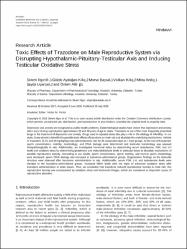| dc.contributor.author | Ilgın, Sinem | |
| dc.contributor.author | Aydoğan-Kılıç, Gözde | |
| dc.contributor.author | Baysal, Merve | |
| dc.contributor.author | Kılıç, Volkan | |
| dc.contributor.author | Ardıç, Mina | |
| dc.contributor.author | Uçarcan, Şeyda | |
| dc.contributor.author | Atlı Eklioğlu, Özlem | |
| dc.date.accessioned | 2019-10-19T16:02:50Z | |
| dc.date.available | 2019-10-19T16:02:50Z | |
| dc.date.issued | 2018 | |
| dc.identifier.issn | 1942-0900 | |
| dc.identifier.issn | 1942-0994 | |
| dc.identifier.uri | https://dx.doi.org/10.1155/2018/7196142 | |
| dc.identifier.uri | https://hdl.handle.net/11421/13941 | |
| dc.description | WOS: 000441517900001 | en_US |
| dc.description | PubMed ID: 30151072 | en_US |
| dc.description.abstract | Depression and anxiety are recognized as public health problems. Epidemiological studies have shown that depression and anxiety often occur during reproductive ages between 20 and 60 years of age in males. Trazodone is one of the most frequently prescribed drugs in the treatment of depression and anxiety. Drugs used in repeated doses also play a role in the etiology of infertility. In our study, it was aimed to identify the possible toxic effects of trazodone on male rats and elucidate the underlying mechanisms. Vehicle or trazodone (5, 10, and 20 mg/kg/day) was administered to rats for 28 consecutive days (n = 8 per group). At the end of that period, sperm concentration, motility, morphology, and DNA damage were determined and testicular morphology was assessed histopathologically in rats. Additionally, we investigated hormonal status by determining serum testosterone, FSH, and LH levels and oxidative stress by determining glutathione and malondialdehyde levels in testicular tissue to elucidate mechanisms of possible reproductive toxicity. According to our results, sperm concentration, sperm motility, and normal sperm morphology were decreased; sperm DNA damage was increased in trazodone-administered groups. Degenerative findings on the testicular structure were observed after trazodone administration in rats. Additionally, serum FSH, LH, and testosterone levels were elevated in the trazodone-administered groups. Increased MDA levels were the signs of enhanced oxidative stress after trazodone administration in testis tissues. Thus, we concluded that trazodone induced reproductive toxicity in male rats; this reproductive toxicity was accompanied by oxidative stress and hormonal changes, which are considered as important causes of reproductive disorders. | en_US |
| dc.language.iso | eng | en_US |
| dc.publisher | Hindawi LTD | en_US |
| dc.relation.isversionof | 10.1155/2018/7196142 | en_US |
| dc.rights | info:eu-repo/semantics/openAccess | en_US |
| dc.title | Toxic Effects of Trazodone on Male Reproductive System via Disrupting Hypothalamic-Pituitary-Testicular Axis and Inducing Testicular Oxidative Stress | en_US |
| dc.type | article | en_US |
| dc.relation.journal | Oxidative Medicine and Cellular Longevity | en_US |
| dc.contributor.department | Anadolu Üniversitesi, Eczacılık Fakültesi, Farmasötik Toksikoloji Anabilim Dalı | en_US |
| dc.relation.publicationcategory | Makale - Uluslararası Hakemli Dergi - Kurum Öğretim Elemanı | en_US] |
| dc.contributor.institutionauthor | Ilgın, Sinem | |
| dc.contributor.institutionauthor | Kılıç, Volkan | |
| dc.contributor.institutionauthor | Uçarcan, Şeyda | |
| dc.contributor.institutionauthor | Atlı Eklioğlu, Özlem | |


















